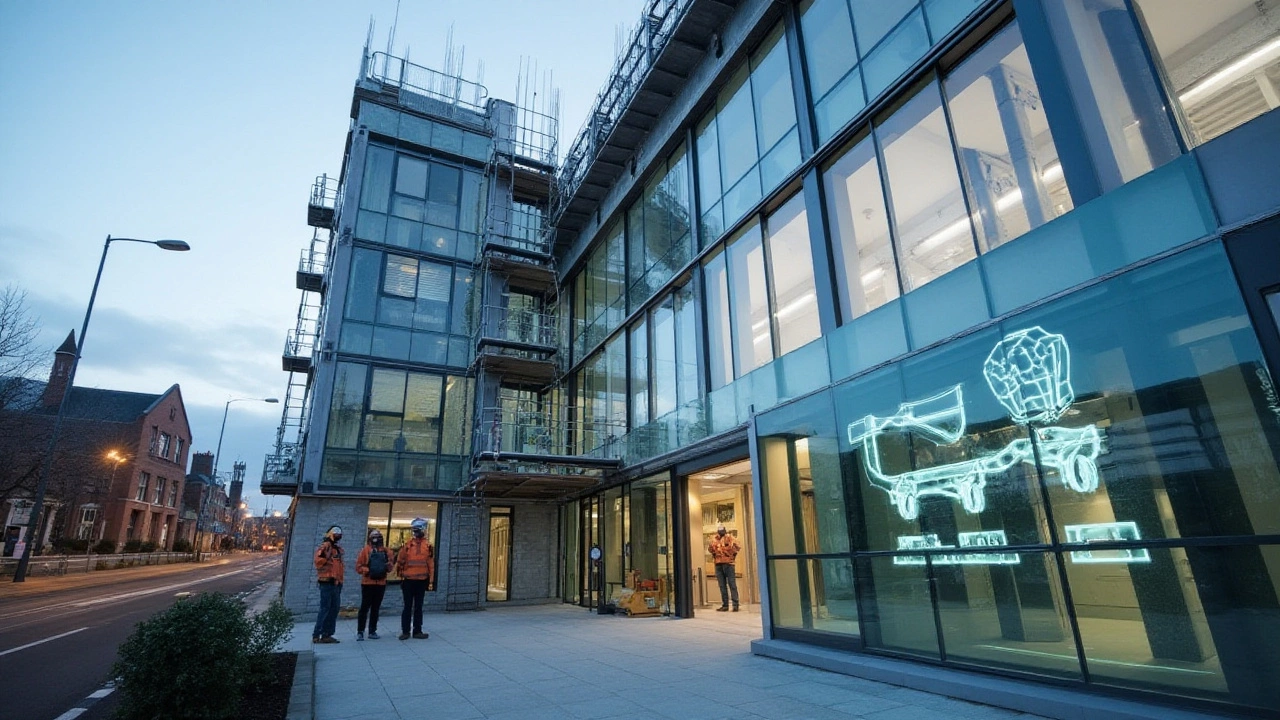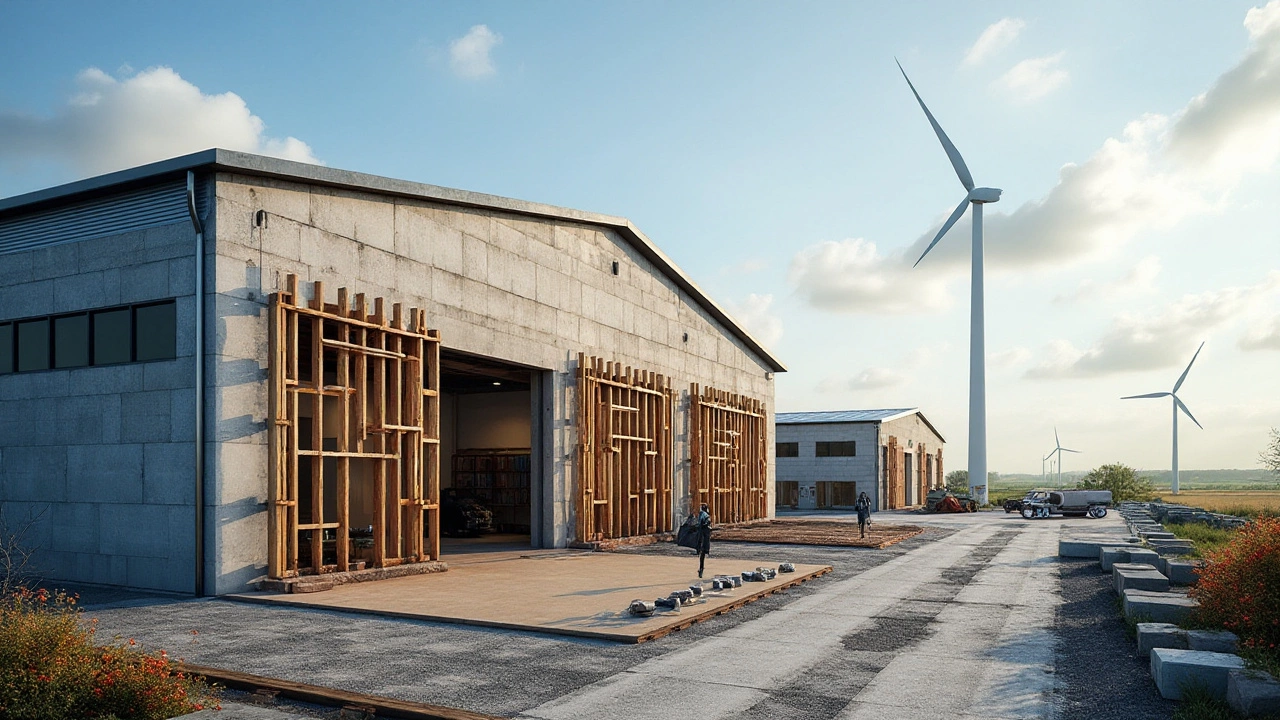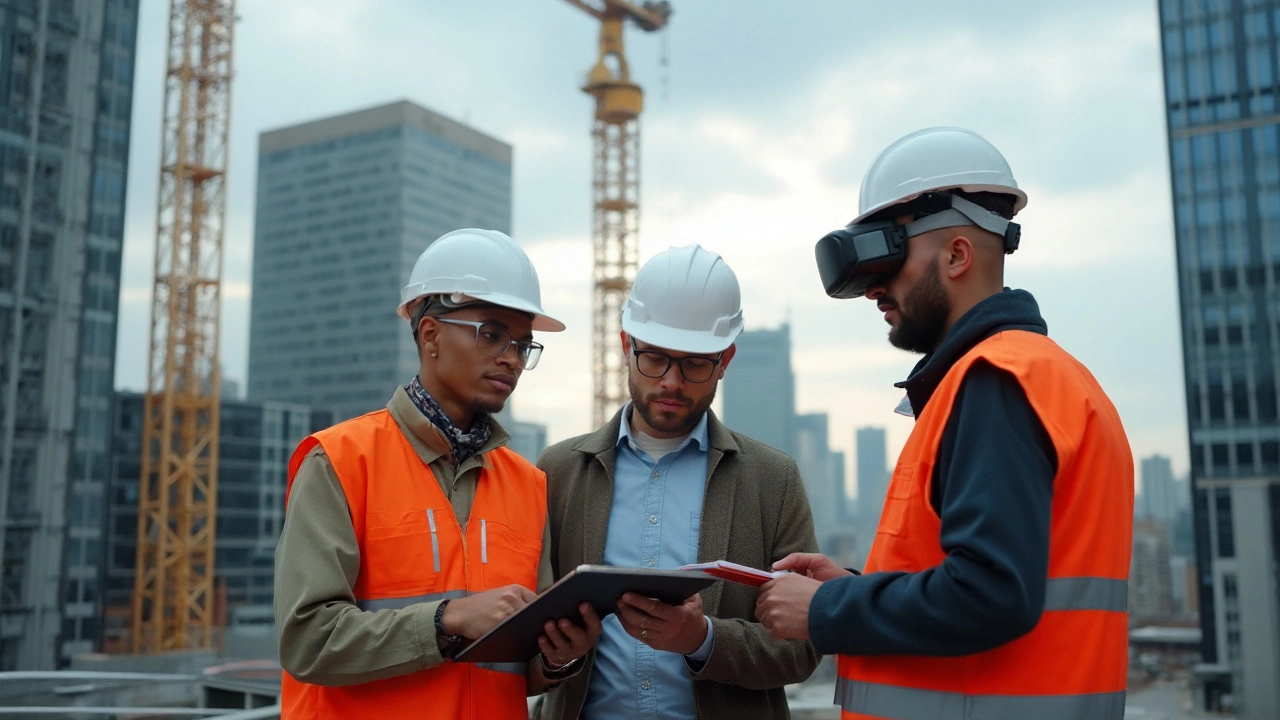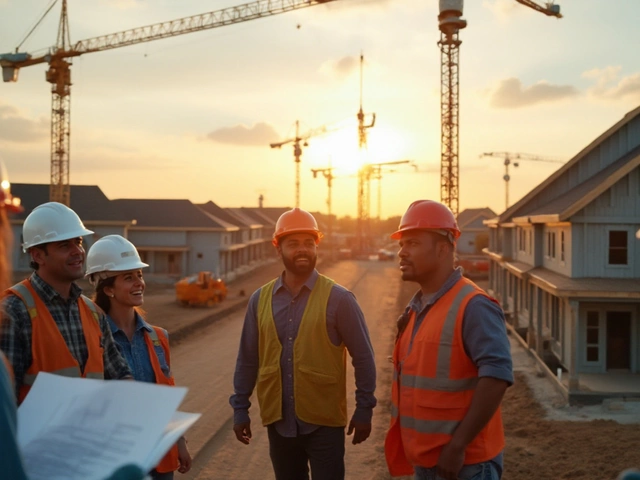The world of commercial construction presents a fascinating canvas of opportunity and innovation. This thriving industry encompasses a variety of projects, each designed with specific purposes and unique characteristics in mind. From the bustling aisles of retail facilities to the quiet corridors of office spaces, each type tells its own story in the urban landscape.
As we delve deeper into the types of commercial construction, it's clear that each project demands careful planning and execution to suit its intended function. Whether we're talking about the logistical marvels of industrial buildings or the inviting aesthetics of hotels and entertainment venues, the details matter. Understanding these nuances not only helps professionals thrive in the sector but also ensures sustainable and successful outcomes. Let's take a closer look at these four pivotal types of construction endeavors.
- Retail Facility Construction
- Office Building Projects
- Industrial Structures
- Hospitality and Entertainment Venues
- Key Considerations in Commercial Construction
- Innovations Shaping the Future
Retail Facility Construction
Retail Facility Construction is the backbone of the marketplace where commerce meets community. These constructions are not just about erecting buildings; they are about creating spaces where customers can engage and interact with brands in meaningful ways. The intricate process involves a number of critical phases, each with its own set of challenges and solutions. From site selection to final fittings, the journey is a partnership between architects, contractors, and clients, all striving to bring a vision to life in a way that marries functionality with aesthetic appeal.
The location of a retail facility is a significant decision that can dramatically affect its success. Factors such as foot traffic, accessibility, and surrounding businesses play an essential role in choosing the right spot. Construction teams must also consider zoning laws and regulations which can vary widely depending on the region. Once a location is chosen, designing a space that is inviting, engaging, and conducive to shopping is paramount. Today's consumers expect retail environments to offer an experience, not just products, and this shifts the focus to creating areas that are aesthetically pleasing and easily navigable.
Design flexibility is another critical feature of modern commercial construction projects like retail outlets. Retail spaces changing hands is a common occurrence, and the ability to adapt these spaces to new brands quickly and cost-effectively is a valuable trait. Technological advancements play a significant role here, with virtual models and simulations allowing teams to visualize the end-product before a single brick is laid. Indoor layouts benefit from these innovations, allowing planners to optimize their designs for customer flow and product placement effectively.
Construction of retail facilities also highlights the importance of adhering to sustainability practices. With increasing awareness and demand for eco-friendly structures, the use of sustainable materials and energy-efficient technologies is no longer optional. Retailers are prioritizing designs that minimize environmental impact while maximizing cost savings in utilities. An emerging trend is the integration of renewable energy sources such as solar panels, which align with both environmental goals and financial incentives.
One aspect worth noting is the dynamic between retail trends and architectural innovations, which often go hand in hand. Traditional storefronts are seeing a transformation towards mixed-use spaces which include dining and recreational areas. This shift reflects consumers' desires for experiences beyond shopping, urging designers to rethink and reimagine the typical building projects in city settings. Incorporating open spaces, community centers, and even venues for events, these modern retail environments are responding to a new era of consumer expectations.
"The key to modern retail facility construction lies in flexibility and sustainability," says Jane Doe, a leading architect and thought leader in the industry. "We must think beyond the conventional shopping experience and create spaces that connect with lifestyles and the environment."
Statistics show that retail construction remains a vibrant sector of the construction industry, marked by steady growth and innovation. According to recent data, the retail construction segment is expected to continue expanding, fueled by evolving consumer habits and technological integration within the industry. Whether it's through the rise of e-commerce or brick-and-mortar fusion strategies, retail facility construction is undoubtedly an exciting and ever-changing field in the commercial construction landscape.
Office Building Projects
Office building projects are among the essential cornerstones of the commercial construction landscape. As we witness cities evolving into bustling hubs of economic activity, the demand for innovative and efficient office spaces is at an all-time high. These projects cater to the dynamic needs of modern businesses, fostering environments that enhance productivity and collaboration. When diving into the intricacies of planning and designing office buildings, architects and developers must consider both the functional and aesthetic elements. This balance is crucial, as the interior layout directly impacts employee well-being and efficiency.
The construction of office buildings is characterized by several distinctive phases, starting from land acquisition and zoning compliance to the final touches of interior design. Sustainability has become a pivotal aspect, with a growing emphasis on harnessing renewable materials and energy-efficient systems. Integrating smart technology is another trend shaping the sector, allowing businesses to adapt spaces to their specific needs seamlessly. The implementation of IoT devices and advanced security features has revolutionized how offices operate, pushing traditional boundaries.
Interestingly, many office projects now include flexible workspaces alongside dedicated zones. These adaptable environments cater to the changing demands of the workforce, with an emphasis on open-plan layouts that can accommodate varying team sizes and activities. This shift has been driven by the immense success of co-working models, which have redefined what office spaces can offer. Such innovation is echoed by Jessica Houghton, a renowned urban planner, who once said,
"The future of work lies not in fixed cubicles but in fluid spaces that adapt as quickly as the businesses within them."
Create spaces that accommodate evolving technologies and practices is also crucial. Many modern office buildings focus on sustainability, incorporating features like green roofs, solar panels, and rainwater harvesting systems. These contribute not only to environmental preservation but can also significantly lower operational costs. Workspace wellness is another emerging trend, where ample light, indoor plants, and ergonomic design are integrated to create a healthier environment for employees. Statistics suggest that employee satisfaction and productivity increase when they work in such environments, marking a shift in how businesses perceive the role of their office space.
Among the compelling aspects of office building projects is the emphasis on sustainability. Incorporating green building practices has transcended mere trend status; it's now a pivotal factor in project development. The Leadership in Energy and Environmental Design (LEED) certification is often pursued, rewarding structures that exemplify energy efficiency and environmental stewardship. An illuminating study showed that LEED-certified buildings recorded a 25% energy savings compared to conventional office buildings, illustrating the tangible benefits of going green.
Office buildings also reflect cultural and economic contexts, serving as architectural manifestations of a company's values and ethos. Recently, biophilic designs have gained traction, integrating natural elements like greenery, water features, and organic materials into corporate spaces. This trend fosters a connection between occupants and the natural world, enhancing mental health and creativity. The commercial construction industry recognizes that a well-designed office is more than its walls and ceilings; it forms the bedrock of a thriving business community.

Industrial Structures
Industrial structures form the backbone of our modern economy, playing an integral role in manufacturing, production, and storage processes. These facilities are designed to meet specific operational needs, often tailored to accommodate heavy machinery, extensive production lines, and optimal workforce logistics. The construction of such structures requires meticulous planning to ensure compliance with safety regulations, efficiency in workflow, and adaptation to technological advancements. This type of commercial construction is essential as these facilities often emphasize durability, with the use of reinforced concrete, steel frameworks, and specialized coatings to withstand various environmental factors.
One striking example of innovation in industrial structures is the rise of smart factories. These facilities integrate cutting-edge technologies such as IoT (Internet of Things), robotics, and AI to streamline production processes and improve efficiency. Such advancements not only enhance productivity but also facilitate a responsive and adaptive manufacturing environment. According to a study by McKinsey, companies that utilize smart technologies in their production lines can see reductions in operational costs by up to 30%. This significant improvement highlights the transformative impact of technology in the construction industry.
Building industrial facilities often involves unique challenges related to zoning laws, environmental impact assessments, and logistical considerations. Site selection is crucial, with proximity to transportation hubs and access to necessary utilities being pivotal factors influencing decision-making. The design must also reflect considerations related to sustainability, energy efficiency, and minimal environmental footprint, as these aspects are becoming increasingly prioritized in modern construction projects. According to the National Institute of Standards and Technology, integrating sustainable design in industrial constructions can lead to energy savings of up to 35%, supporting long-term operational cost reductions.
Success in this realm often requires a comprehensive, multidisciplinary approach. Collaboration between architects, engineers, and project managers is essential to ensure that every aspect—from initial planning through execution—is addressed with precision. Incorporating flexibility into the design also allows these building projects to accommodate future expansions or technological upgrades with ease. The ability to adapt is particularly important as market demands and technological capabilities evolve rapidly over time. In the words of industry expert Frank Gehry, "Industrial structures should not only serve their functional requirements but should also inspire innovation and progress from within."
Hospitality and Entertainment Venues
In the realm of commercial construction, hospitality and entertainment venues stand out for their unique flair and purpose-driven design. These constructions are not just about erecting buildings but crafting spaces that offer an enriching experience. Whether it's a luxurious hotel by the seaside or a buzzing urban entertainment hub, each venue is meticulously designed to meet specific needs and expectations. Essential elements such as ambience, amenities, and service workflows are integrated into the construction process, often requiring creative and innovative approaches.
One of the striking features of these projects is their emphasis on aesthetics combined with functionality. Designers and architects often focus on creating a visually appealing environment that is easy to navigate. It's crucial for these venues to offer comfort and accessibility, catering to a diverse clientele from business travelers to leisure seekers. This multi-faceted approach extends to construction techniques as well, including sustainable practices that are increasingly in demand. With the global emphasis on eco-friendly design, many venues aim to achieve LEED certification by incorporating energy-efficient solutions and sustainable materials. In fact, according to a 2022 survey by the Green Building Council, 60% of new hotels were built following green building practices.
Trends and Innovations
Advancements in technology significantly influence how hospitality and entertainment venues are built and operated. The integration of smart technology is one of the most prominent trends in this sector. From smart lighting systems that adapt to natural light conditions to advanced HVAC systems that enhance comfort while conserving energy, these tech-driven innovations are making a mark. Artificial intelligence is also playing a pivotal role, offering personalized guest experiences through data-driven insights.
"The modern hotel is a digital ecosystem. We harness data to create personalized experiences that exceed the expectations of our guests," said Jane Fisher, CTO of a leading hotel chain, in a 2023 interview with Hospitality Tech Magazine.
The growing focus on diverse entertainment options also leads to the incorporation of mixed-use facilities. Venues are increasingly being designed to host various functions under one roof, such as conferences, concerts, and exhibitions. This adaptability not only maximizes revenue but also attracts a broader audience. Experts predict that by 2030, mixed-use venues will account for nearly 50% of all new hospitality constructions. This trend reflects a shift towards versatile and resilient design in response to evolving market demands.
In conclusion, the hospitality and entertainment sector of commercial construction is ever-evolving, driven by creativity, innovation, and an unwavering commitment to guest satisfaction. Builders, architects, and developers must stay ahead of trends and incorporate cutting-edge technology and sustainable practices to create spaces that are not only functional but enchanting. As the industry continues to grow and adapt, these venues will remain a vibrant and indispensable part of our urban and rural landscapes.

Key Considerations in Commercial Construction
Taking on a commercial construction project is no small feat, and there are numerous factors that need to be considered to ensure a successful outcome. One of the primary considerations is understanding the specific requirements and functionality of the building type. This means knowing what a retail facility might necessitate as opposed to an office structure or an industrial site. For instance, retail spaces often prioritize customer flow and ease of access, necessitating open layouts and strategic placement of aisles and display areas. In contrast, office buildings focus on maximizing space for workstations and meeting rooms, often incorporating advanced HVAC systems and energy-efficient windows to enhance productivity and comfort.
Budget management also plays a crucial role in commercial construction endeavors. Every project comes with a set budget that needs to cover costs from design to completion. This requires meticulous planning and tracking of expenses to avoid overruns. Utilizing advanced software for budget estimates and real-time monitoring can aid in keeping costs aligned with expectations. It's noteworthy that according to industry stats, around 85% of commercial projects either see delays or cost escalations, primarily due to inadequate initial budgeting and unforeseen site conditions.
Another significant factor is regulatory compliance. The construction industry is heavily regulated, and understanding local zoning laws, building codes, and environmental standards is imperative. This compliance ensures safety and sustainability, and neglecting these can lead to legal issues or even project halts. Engaging with experienced professionals who are familiar with these regulations is key to navigating this complexity seamlessly.
Environmental impact and sustainability are becoming increasingly important in the construction industry. Using eco-friendly materials and sustainable building practices not only contributes positively to the environment but may also attract eco-conscious clients. Integrating technologies like solar panels and energy-efficient lighting can enhance a building's green credentials. As per recent data from the Construction Association, projects incorporating sustainable strategies saw a 15% boost in investor interest due to the growing demand for environmentally responsible developments.
Aligning the project with client expectations is another vital piece of the puzzle. Misalignment can lead to redesigns and increased costs, so regular communication with stakeholders is essential. By holding frequent meetings and walkthroughs, project managers can ensure that the development aligns closely with the client's vision, ultimately enhancing satisfaction and fostering long-term collaborations.
Lastly, workforce management is crucial in commercial construction projects. Skilled labor is the backbone of any construction project, and ensuring that the team is well-coordinated, informed, and motivated can greatly enhance productivity and quality. A well-documented plan with clear milestones can keep the workforce organized and focused on the deadlines. Many industry experts, including Daniel B. Honig in his acclaimed book, state, "A project's success is a reflection not just of design and materials, but of the people behind it."
Innovations Shaping the Future
The sphere of commercial construction is undergoing a fascinating transformation, driven largely by cutting-edge innovations and technological breakthroughs. Among these developments, the use of Building Information Modeling (BIM) has revolutionized how architectural designs are conceptualized and executed. BIM promotes enhanced collaboration by allowing stakeholders to access detailed visualization of projects, which contributes to improved efficiency and reduced errors during the construction phase. This digital format integrates data across architecture, engineering, and construction disciplines, fostering a transparent environment for all parties involved.
Another technological leap that is reshaping the industry is the advent of sustainable building materials. With environmental concerns at an all-time high, the demand for eco-friendly solutions is pushing innovators to develop materials that not only excel in durability but also minimize ecological footprint. Materials like cross-laminated timber and insulated concrete forms are gaining popularity for their sustainable properties and efficiency in building robust industrial structures. The shift towards green construction not only aligns with global sustainability goals but also offers significant economic benefits through energy savings and increased property value.
Beyond materials, smart building technologies are rapidly becoming a standard in new commercial projects. These systems leverage the Internet of Things (IoT) to enhance the functionality of hospitality and entertainment venues by providing features like energy management, enhanced security, and personalized user experiences. Smart technologies allow for real-time data monitoring and adjustments to environmental controls, enhancing the comfort and safety of occupants while optimizing resource use.
"The construction industry stands on the brink of a technological revolution that will fundamentally alter design and build processes. Integrating smart building systems is not just an option; it is becoming a necessity for the industry," notes a report by McKinsey & Company.
The implementation of automation and robotics within construction sites is also starting to make waves. From autonomous vehicles that transport supplies to robotic bricklaying machines that speed up the masonry process, automation promises to reduce labor costs while improving precision and safety on-site. As these technologies evolve, their integration could address labor shortages and boost productivity across various commercial construction types.
Statistics from a 2023 industry analysis illustrate that nearly 30% of new office building projects incorporated at least one form of robotics or automation during the construction phase. As firms continue to adopt these technologies, the efficiencies introduced are expected to drive down costs and lead times, influencing broader trends throughout the construction market.





